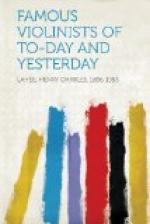This celebration was, however, quite eclipsed by that of the sixtieth anniversary of his first public appearance, which was held at Berlin on April 22, 1899. A grand concert was given at the Philharmonie, with an orchestra consisting of two hundred performers. There were ninety violins, thirty violas, twenty-one ’celli, and twenty double-basses, and of these all except the double-basses had been pupils of Joachim, the violas and ’celli having been his pupils in chamber music. They had come from all over Europe to take part in the festival. Nearly half of the violins were concert-masters, and many of them famous soloists, as Carl Halir, Henri Petri, Jeno Hubay, Willy Hess, Gustav Hollaender, Gabrielle Wietrowitz, Marie Soldat, and others.
Joachim entered the hall at half-past six, and was greeted with a deafening fanfare played by the combined trumpeters of the military bands stationed in Berlin. The audience rose in a body and added its cheers to the noise of the trumpets. A large armchair, beautifully decorated with flowers and wreaths, was reserved as a seat of honour for the great musician.
The seventh number on the programme was left vacant, but when it was reached the orchestra began the introduction to Beethoven’s concerto. No soloist was in sight, but Gabrielle Wietrowitz and Marie Soldat, his most celebrated women pupils, came slowly down toward Joachim’s chair, one carrying a violin and the other a bow, which they placed in his hands. Joachim, however, did not wish to play, and did not yield except under the force of persuasion, and then he said: “I have not had a violin in my hands for three days; I am in no mood to play; moreover, there are many in the orchestra who can play it better than I, but I don’t want to refuse.” So Joachim played the great concerto, and received an ovation such as had probably never been accorded to him before. Then he conducted Bach’s concerto in G major for strings, which was played by sixty-six violins, fifty-seven violas, twenty-four ’celli, and twenty double-basses, and this brought the concert to a close.
The concert was followed by a banquet at which there were eight hundred guests, and the festivities lasted until four o’clock the next morning. No violinist was ever more respected or beloved by his pupils, nor did one ever wield a more powerful influence in the musical world. To be put forward by Joachim gives one a high standing in the musical world to begin with, but few indeed are those who receive this privilege in comparison with those who desire it.
Joachim is not a builder of technique or a teacher of beginners. Pupils who are accepted by him must be already proficient technicians, and it may be stated that the teacher who can prepare pupils for Joachim stands high in the profession. Joachim is a great adviser, a former of style, and a master of interpretation, to whom pupils flock two or three years too early, and feel aggrieved if they are not at once accepted.




